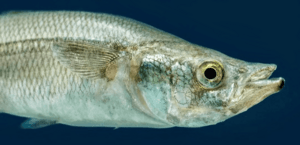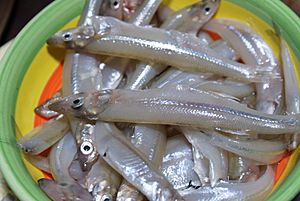Chirostoma facts for kids
Quick facts for kids Chirostoma |
|
|---|---|
 |
|
 |
|
| Chirostoma lucius (above) Chirostoma estor (below) |
|
| Scientific classification |
|
| Kingdom: | Animalia |
| Phylum: | Chordata |
| Class: | Actinopterygii |
| Order: | Atheriniformes |
| Family: | Atherinopsidae |
| Subfamily: | Menidiinae |
| Tribe: | Mendiniini |
| Genus: | Chirostoma Swainson, 1839 |
| Type species | |
| Atherina humboldtiana Valenciennes 1835
|
|
| Synonyms | |
|
|
Chirostoma is a group of fish found in the Lerma River area in Mexico. This includes famous lakes like Chapala and Pátzcuaro. These fish are also known as charal or charales in Mexico.
People fish for charales a lot. But sadly, many types of these fish are now endangered. This is because their homes are being lost due to pollution, too much water being taken out, and dry weather. Also, new types of fish brought into their waters and too much fishing have caused problems. Three kinds of charales are already gone forever, and four more might be extinct too.
Contents
About Charales
What They Look Like
Charales are usually silvery-white, light gray-brown, or dull yellowish. They have a long line on their side, which can be hard to see in some types. These fish come in different sizes. Some are less than 10 cm (4 in) long, while others can grow to be over 40 cm (1.3 ft) long.
How They Eat and Live
Charales are filter feeders. This means they eat tiny things from the water. Their main diet includes small creatures like tiny crustaceans (copepods, cladocerans), rotifers, and insect larvae. They also eat fish eggs and embryos.
These fish are special because they are ovoviviparous. This means the eggs hatch inside the mother's body. Then, the live baby fish are born. The eggs are fertilized outside the mother's body. During spawning, which is when fish lay eggs, each female lays hundreds or even thousands of eggs.
Types of Charales
There are currently 23 different kinds of charales recognized by scientists. Sometimes, the four types of Poblana fish are also considered part of the Chirostoma group. Different types of charales can sometimes breed with each other, creating hybrid fish.
Here are the recognized species:
- Chirostoma aculeatum C. D. Barbour, 1973 (Scowling silverside)
- Chirostoma arge (D. S. Jordan & Snyder, 1899) (Largetooth silverside)
- Chirostoma attenuatum Meek, 1902 (Slender silverside)
- †Chirostoma bartoni D. S. Jordan & Evermann, 1896 (Alberca silverside)
- Chirostoma chapalae D. S. Jordan & Snyder, 1899 (Smallmouth silverside)
- †Chirostoma charari (F. de Buen, 1945) (Least silverside)
- †Chirostoma compressum F. de Buen, 1940
- Chirostoma consocium D. S. Jordan & C. L. Hubbs, 1919 (Ranch silverside)
- Chirostoma contrerasi C. D. Barbour, 2002 (Ajijic silverside)
- Chirostoma copandaro F. de Buen, 1945
- Chirostoma estor D. S. Jordan, 1880 (Pike silverside)
- Chirostoma grandocule (Steindachner, 1894) (Bigeye silverside)
- Chirostoma humboldtianum (Valenciennes, 1835) (Shortfin silverside)
- Chirostoma jordani Woolman, 1894 (Charal)
- Chirostoma labarcae Meek, 1902 (Sharpnose silverside)
- Chirostoma lucius Boulenger, 1900 (Longjaw silverside)
- Chirostoma melanoccus Álvarez, 1963 (Blunthead silverside)
- Chirostoma patzcuaro Meek, 1902 (Patzcuaro silverside)
- Chirostoma promelas D. S. Jordan & Snyder, 1899 (Blacknose silverside)
- Chirostoma reseratum Álvarez, 1963
- Chirostoma riojai Solórzano & Y. López, 1966 (Toluca silverside)
- Chirostoma sphyraena Boulenger, 1900 (Bigmouth silverside)
- Chirostoma zirahuen Meek, 1902
Charales in the Kitchen
Dried charales are a popular food in Mexico. You can fry them with salt and lemon. Sometimes, they are covered with fried egg and garlic or chili. They can also be added to omelettes or fried pancakes with green sauce.
Where to Find Charales
You can buy charales at restaurants near Lake Chapala and in local markets. They are usually sold dried and are not very expensive. One type, C. estor, is raised in special fish farms called aquaculture facilities. Another type, C. humboldtianum, has also been raised in captivity and might be farmed more in the future.
See also
 In Spanish: Charales para niños
In Spanish: Charales para niños


